I N S I D E T H I S I S S U E
insidethisissue - The Royal Astronomical Society of Canada
insidethisissue - The Royal Astronomical Society of Canada
- No tags were found...
Create successful ePaper yourself
Turn your PDF publications into a flip-book with our unique Google optimized e-Paper software.
elation between mass and energy,E = mc 2 , as a consequence of the specialtheory of relativity. Einstein’s equationshowed that a tiny amount of mass could,in principle, be converted into a tremendousamount of energy. His relation generalizedand extended the nineteenth century lawof conservation of energy of von Helmholtzand Mayer to include the conversion ofmass into energy.What was the connection betweenEinstein’s equation and the energy sourceof the sun? The answer was not obvious.Astronomers did their part by definingthe constraints that observations of starsimposed on possible explanations ofstellar energy generation. In 1919, HenryNorris Russell, the leading theoreticalastronomer in the United States,summarized in a concise form theastronomical hints on the nature of thestellar energy source. Russell stressedthat the most important clue was thehigh temperature in the interiors of stars.F. W. Aston discovered in 1920 thekey experimental element in the puzzle.He made precise measurements of themasses of many different atoms, amongthem hydrogen and helium. Aston foundthat four hydrogen nuclei were heavierthan a helium nucleus. This was not theprincipal goal of the experiments heperformed, which were motivated in largepart by looking for isotopes of neon.The importance of Aston’smeasurements was immediately recognizedby Sir Arthur Eddington, the brilliantEnglish astrophysicist. Eddington arguedin his 1920 presidential address to theBritish Association for the Advancementof Science that Aston’s measurement ofthe mass difference between hydrogenand helium meant that the sun couldshine by converting hydrogen atoms tohelium. This burning of hydrogen intohelium would (according to Einstein’srelation between mass and energy) releaseabout 0.7% of the mass equivalent of theenergy. In principle, this could allow thesun to shine for about a 100 billion years.In a frighteningly prescient insight,Eddington went on to remark about theconnection between stellar energygeneration and the future of humanity:If, indeed, the sub-atomic energyin the stars is being freely usedto maintain their great furnaces,it seems to bring a little nearerto fulfillment our dream ofcontrolling this latent power forthe well-being of the human race— or for its suicide.IV. Understandingthe ProcessThe next major step in understandinghow stars produce energy from nuclearburning resulted from applying quantummechanics to the explanation of nuclearradioactivity. This application was madewithout any reference to what happensin stars. According to classical physics,two particles with the same sign of electricalcharge will repel each other, as if theywere repulsed by a mutual recognitionof “bad breath.” Classically, the probabilitythat two positively charged particles getvery close together is zero. But somethings that cannot happen in classicalphysics can occur in the real world whichis described on a microscopic scale byquantum mechanics.In 1928, George Gamow, the greatRussian-American theoretical physicist,derived a quantum-mechanical formulathat gave a non-zero probability of twocharged particles overcoming their mutualelectrostatic repulsion and coming veryclose together. This quantum mechanicalprobability is now universally known asthe “Gamow factor.” It is widely used toexplain the measured rates of certainradioactive decays.In the decade that followed Gamow’sepochal work, Atkinson and Houtermansand later Gamow and Teller used theGamow factor to derive the rate at whichnuclear reactions would proceed at thehigh temperatures believed to exist inthe interiors of stars. The Gamow factorwas needed in order to estimate how oftentwo nuclei with the same sign of electricalcharge would get close enough togetherto fuse and thereby generate energyaccording to Einstein’s relation betweenexcess mass and energy release.In 1938, C. F. von Weizsäcker cameclose to solving the problem of how somestars shine. He discovered a nuclear cycle,now known as the carbon-nitrogen-oxygen(CNO) cycle, in which hydrogen nucleicould be burned using carbon as a catalyst.However, von Weizsäcker did notinvestigate the rate at which energy wouldbe produced in a star by the CNO cycle,nor did he study the crucial dependenceupon stellar temperature.By April 1938, it was almost as if thescientific stage had been intentionallyset for the entry of Hans Bethe, theacknowledged master of nuclear physics.Professor Bethe had just completed aclassic set of three papers in which hereviewed and analyzed all that was thenknown about nuclear physics. These workswere known among his colleagues as“Bethe’s bible.” Gamow assembled a smallconference of physicists and astrophysicistsin Washington, D. C. to discuss the stateof knowledge, and the unsolved problems,concerning the internal constitution ofthe stars.In the course of the next six monthsor so, Bethe worked out the basic nuclearprocesses by which hydrogen is burned(fused) into helium in stellar interiors.Hydrogen is the most abundant constituentof the sun and similar stars, and indeedthe most abundant element in the universe.Bethe described the results of hiscalculations in a paper entitled “EnergyProduction in Stars,” which is awesometo read. He authoritatively analyzed thedifferent possibilities for reactions thatburn nuclei and selected as most importantthe two processes that we now believeare responsible for sunshine. One process,the so-called p – p chain, builds heliumout of hydrogen and is the dominantenergy source in stars like the sun andless massive stars.The CNO cycle, the second processwhich was also considered by vonWeizsäcker, is most important in starsthat are more massive than the sun. Betheused his results to estimate the centraltemperature of the sun and obtained avalue that is within 20% of what wecurrently believe is the correct value (16million degrees Kelvin) 2 . Moreover, heshowed that his calculations led to a222JRASC December / décembre 2000
















